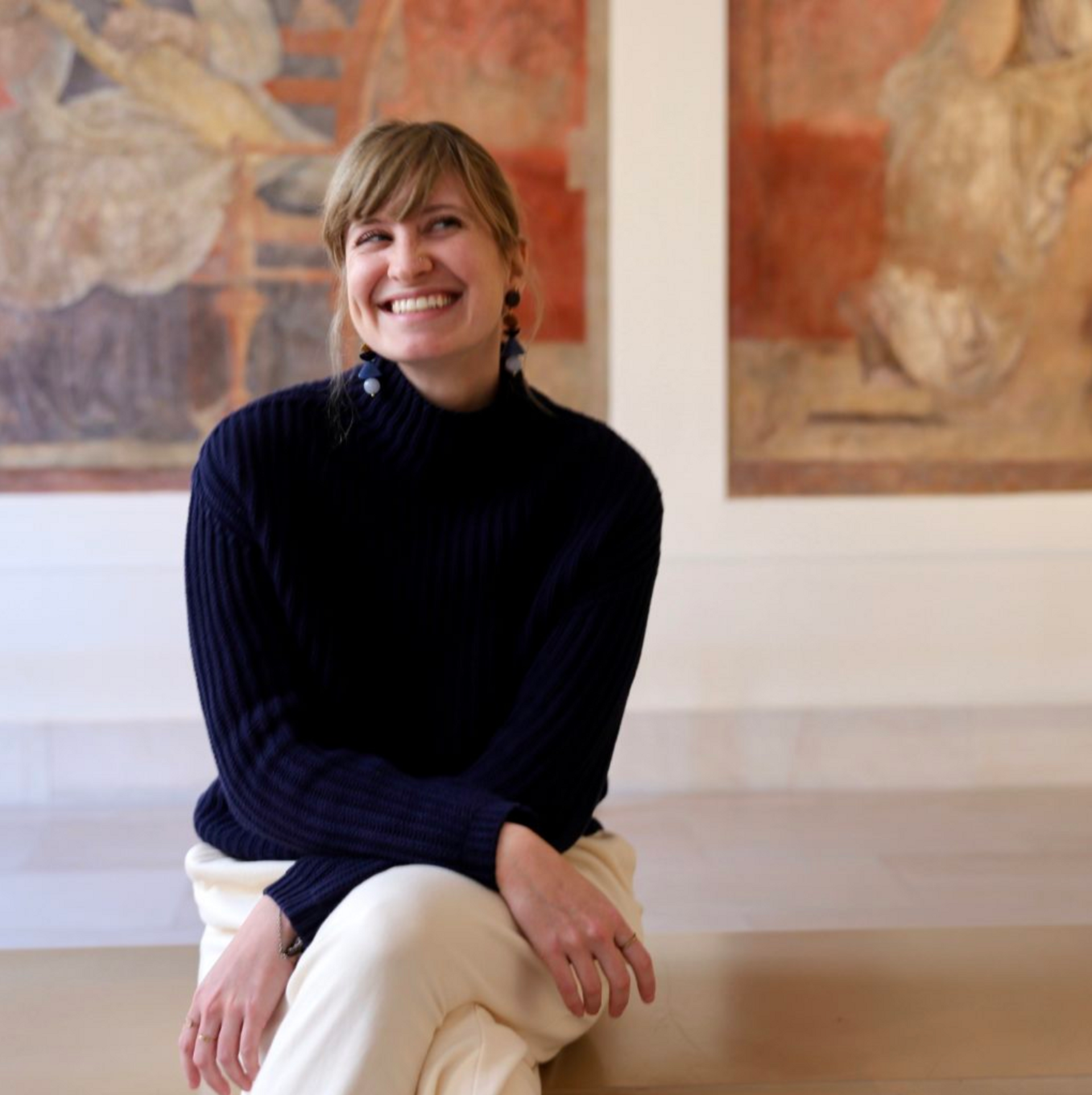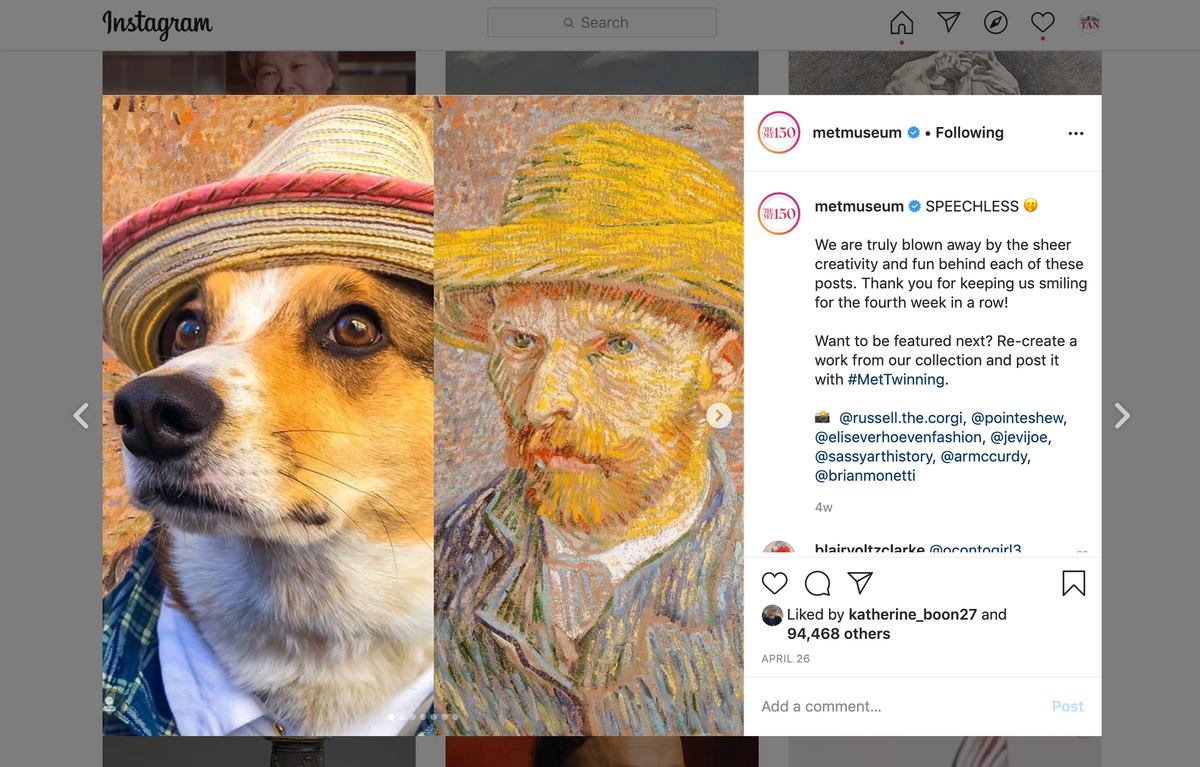“So much has changed in just a year,” says Claire Lanier, the Metropolitan Museum in New York’s social media manager, who has just celebrated her one-year anniversary on the job—in quarantine. In March last year, Lanier fought off hundreds of other applicants to land the role of communicating directly with the millions of online fans of one of the world’s most popular museums.
Now she’s navigating the murky waters of social media in the age of the coronavirus pandemic. “Everything's changing so much, so rapidly,” Lanier says. “There's been a big increase in terms of engagement. In the first two weeks of lockdown, we saw engagement go up by 95% on Instagram, by 64% on Twitter and by 17% on Facebook. Also of note, in the past nine weeks, impressions on Twitter have increased by 71.2% and on Instagram by almost 50%.”
In our recent research into the most popular social media accounts of museums worldwide, as part of our annual Art’s Most Popular survey, the Met came out as the second most popular after MoMA, with a total following of 9.8 million on Instagram, Twitter and Facebook. Since that data was captured in March, the Met’s follower numbers have increased by more than 165,000 to nearly 10 million in total.
Here we talk to Lanier about her social media strategies, from creating new accounts and utilising livestreams to making—and maintaining—online art world friends.

Claire Lanier is the Metropolitan Museum of Art's senior social media manager Courtesy of Claire Lanier
How has your strategy changed and have you started any new programming since lockdown began?
On the one hand very little has changed because we're always strategising and adjusting what we're showcasing and what we're tapping into, like if there's a museum initiative that other people in the industry are working on. We're always thinking about how we're talking to people who might never in their life visit the Met. But obviously, on the other hand, everything's changed because there are now no components related to attendance, so all of our priorities on digital engagement have elevated.
One of the things I hope to focus on right now is not only providing people with art that they love, which is obviously the point of our accounts, but to also give them creative projects to do. In New York we're not looking to reopen the city yet and even as the as time moves on and things do reopen it's going to be a tiered approach. So I think finding ways to let followers feel creative at home is really important.
We've been thinking about how we can refocus our campaigns to elicit active engagement with people. We were already doing a Met Sketch post every Sunday where we would show works made within our galleries, so we switched up the initiative to invite followers to draw at home. We launched the #MetTwinning campaign to encourage followers to recreate works from our collection and it has really exploded. Each of the posts that we've shared for it has progressively performed better and gotten wider reach. In terms of tone, there's a lot of scope right now to be very authentic—which is always our goal—and talk about the reality of the situation. For example, there has been a lot of coverage about how people are doing their own haircuts during quarantine, so we did a Twitter challenge to find examples of the worst haircuts in museum collections.
Another part of our strategy has been to offer a sense of calm to people, which I think is a natural impulse right now. We all know that art can be a very calming force and be a good medium for reflection. It's important to consider how really dark this time is too, especially here in New York City where many people are ill and there’s been a lot of real tragedy. As a New York institution we feel a responsibility to talk to people in a way that allows them to feel a sense of solace, even if it's momentary.
I imagine your workload is much higher now with so many people turning to social media during lockdown to try and make up for the in-person interactions they are missing day-to-day. Have you seen that people from other departments have been getting more involved in social media?
Yeah, that's true and we've seen tonnes of involvement. I think the curatorial staff have always been pretty well attuned to the significance of digital communication and our digital presence so they're usually very engaged if we have a social media or website idea. But the whole team has been overwhelmingly supportive and full of ideas—I’ve had so many emails with interesting ideas or cool works to feature. The Met also has 30 Instagram accounts from different departments and so those departments have really jumped on board and been working within their smaller teams, too. Several departments have started their own Instagram accounts within the last weeks, including the Islamic department (@metislamicart), the European paintings department (@meteuropeanpaintings) and the Greek and Roman art department (@metgreekandroman).
How do you manage all those Instagram accounts? Is each department responsible for its own?
Yes, they're managed within the departments, and the communications and social media teams have a broad oversight. We advise and offer training and best practices. I know there's at least one account where the department head is the one who does all the posting because they’re really passionate about it while other departments share responsibility as a team. Each account has its own followers and that's actually what's really cool about it.
Which of the departmental Instagram accounts is most popular?
The Costume Institute (@metcostumeinstitute, 303,000 followers), for sure, especially because of the Met Gala and everything associated with that. But the Met Arms and Armour account (@metarmsandarmor) is very popular with almost 50,000 followers, and they have an extremely niche audience. It's a fascinating, beautiful account. Other popular accounts include @metbreuer, @costumeinstitutelibrary and @metlibrary.
A lot of social media functions that haven't been so widely used in the art world, such as livestreaming and screenings, are now being used a lot more. Is that something that you have noticed?
Yes, we're now doing a lot of virtual events and using functions differently than we had before. I’ve seen Instagram live chats explode—we did our first one during lockdown and we're likely to do more. Every Friday at 5pm we stream the musicians who normally play in our balcony bar doing a set from home. Our MetLiveArts performances are being premiered every few weeks on the weekends. We have a weekly live storytime that is shot in the homes of our Met educators. Some of the content is new and some is from events held at the Met that we're finding new ways to share digitally.
We want to think about what can we offer people at home that goes beyond just looking at a work of art and how they can be more immersed in it, especially as people are starting to get exhausted by the internet. We also want to offer things where people don’t feel like they're married solely to a screen. We’ve launched a new playlist called Mixed Media on our Spotify account, which includes music related to art.
Do you think you will continue to use these features moving forward?
I think in the future we could just as easily do a Facebook Live within the museum. The Met is 2 million sq. ft: we could be speaking on two different sides of the museum and doing an Instagram Live! This period is making us think about engaging with these features in ways we might not have previously thought.
The Met’s obviously part of a wider community, both locally and internationally. Do you have any particular institutions that you regularly collaborate with? How do you go about deciding who to work with?
We don't have any specific “best museum friends”. Obviously, we're very connected to the other New York museums and there's a really active museum social media managers community here. We all try to keep up with what's going on with everyone and we do physical meet-ups throughout the year (now on Zoom). I always say these are our peers not our competitors.
When I when I was working at the New York Historical Society in 2018 we partnered with the Museum of the City of New York, and we did a campaign called #MuseumSnowballFight [where museums posted snow-related images from their collections as a way to “throw virtual snowballs” at one another]. That involved a tonne of different museums. There's never really any hierarchy, you're just excited to engage with someone. It's so fun to learn about a museum that you didn't know about in a state that's far away, where they might have a work by the same artist or something like that. I think that's one of the benefits of these broader museum initiatives is that you find new friends.
What would be your biggest tip for social media managers or people with creative accounts who want to extend their social media follower base?
I think one of the things that I always say is that if you're not engaging with other accounts, you're really only doing half the work of social media: the media part. And the social part is just as significant. If you want engagement back on your page then you have to be engaging with other pages, so make sure that you're reaching out to others, that you're commenting on other accounts, and that you're connecting with other institutions. Be a part of whatever your social media community is. Social media is hard work: it may seem like something you just throw together but to put create a post requires research, writing and timing. There's a very strong impulse to devote most of your time to that creator part but don’t forget to create social media friendships. I think that's a really important key to building your presence.


